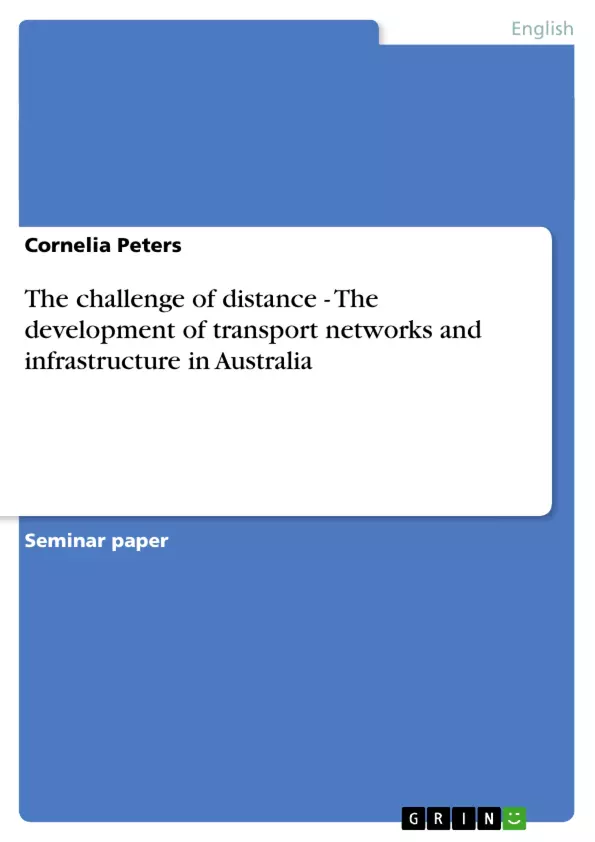Bringing a Country Together - The Conquest of Isolation
The size of the Australian continent is about 7.7 million square kilometers, which equals approximately the size of the United States of America excluding Alaska. Due to its extreme aridity, large areas of Australia are not populated or fit for agricultural and industrial use. Therefore, 86% of its 18.3 million inhabitants live in widely separated cities along the coastal regions, making Australia the most urbanized continent.1 Australia’s coastline has a total length of 36,735 km. Extreme distances between cities have made the transportation network a major concern of the Australian economy. In the more densely populated south-east area of the continent, the distance between Sydney and Melbourne is 880 km. Melbourne and Adelaide are 720 km apart, and from Adelaide to Perth it is 2,675 km along the southern fringe of the Nullarbor Plain. The connection between Adelaide to Darwin via Alice Springs spans a distance of 3,014 km, and between Perth and Darwin the western highway covers approximately 4,000 km. 2 Today, Australia is spanned by approximately 810,000 km of roads and a rail network estimated at 40,000 km. According to Australian government publications from 1994, the industry sector supported by trans- portation networks contributes about six per cent to the total production value of goods and services.3
Inhaltsverzeichnis (Table of Contents)
- Bringing a Country Together - The Conquest of Isolation
- Unorthodox Steps to Conquer Distance - Early Settlement Support via Land and Water
- "Port Capitals" versus the "Urban Frontier" - The Influence of Infrastructure on Australian Urban Development
- Different Strokes for Different Folks - The Drawbacks of Diversity in Railroad Construction
- A New Transport Era - All Aboard!
- Moving Freight and People - Transport Across a Continent
- Employment and the Transport Sector in the 20th Century
- Sea Freight transport as a Viable Alternative
- Air Freight Services by International Airlines
- Passenger Air Transport
- "Road Trains" and "Beef Roads" - Long Distance Truck Transport the Australian Way
- On the Right Track – Reforms and Achievements of Rail Industry
- The "Train of Dreams" - a Transcontinental Connection
- A Journey into History
- Along the Way: A Course in Aboriginal Language and Australian Politics
- The Indian Pacific - Layout, Schedules and Fares
Zielsetzung und Themenschwerpunkte (Objectives and Key Themes)
This work explores the development of Australia's transport network and infrastructure, highlighting the challenges posed by the continent's vast distances and unique geographical features. The study examines how infrastructure has shaped Australian urban development, the influence of diverse transportation modes, and the economic impact of the transport sector.
- The impact of distance and isolation on Australia's development.
- The role of transportation networks in shaping Australia's urban landscape.
- The historical evolution of different transport modes, including rail, road, sea, and air transportation.
- The economic and social significance of the Australian transport sector.
- The challenges and opportunities associated with the development of a comprehensive and efficient transport network.
Zusammenfassung der Kapitel (Chapter Summaries)
The first chapter, "Bringing a Country Together - The Conquest of Isolation," examines the early challenges faced by Australia due to its extreme distances and explores how these challenges were addressed through the development of various transport infrastructure. It highlights the evolution of transportation methods, from the use of land and water routes to the construction of railways. The second chapter, "Moving Freight and People - Transport Across a Continent," delves into the development of the Australian transport sector in the 20th century. It discusses the various modes of transportation, including sea freight, air freight, passenger air transport, and road transport. The chapter explores the impact of these different modes on the Australian economy and society. Finally, the third chapter, "The 'Train of Dreams' - a Transcontinental Connection," focuses on the historical significance and development of the Indian Pacific railway. The chapter details the journey, the historical significance of the railway, and the importance of the line to Aboriginal language and Australian politics.
Schlüsselwörter (Keywords)
The key focus of this work lies on the development of transport networks and infrastructure in Australia, particularly examining the challenges of distance and isolation. The study delves into the historical and contemporary aspects of various transport modes, including road, rail, sea, and air transport. It emphasizes the economic and social impact of these networks, including the influence on urban development and the role of transportation in connecting people and goods across the vast Australian continent.
- Quote paper
- Cornelia Peters (Author), 1999, The challenge of distance - The development of transport networks and infrastructure in Australia, Munich, GRIN Verlag, https://www.grin.com/document/28705



